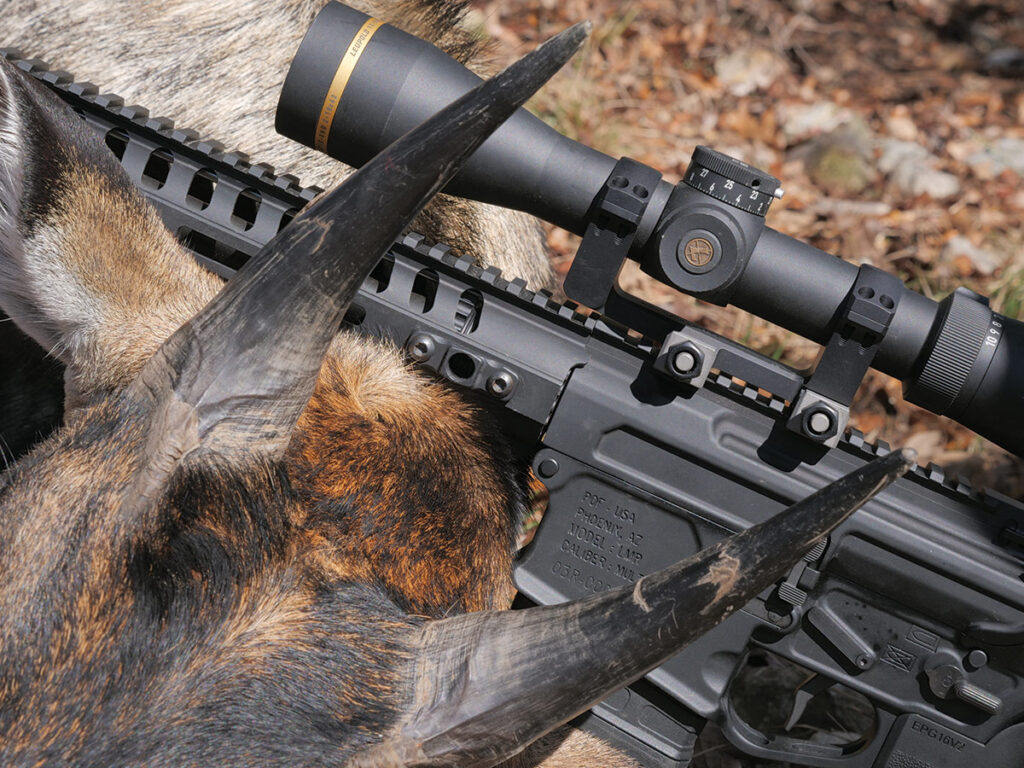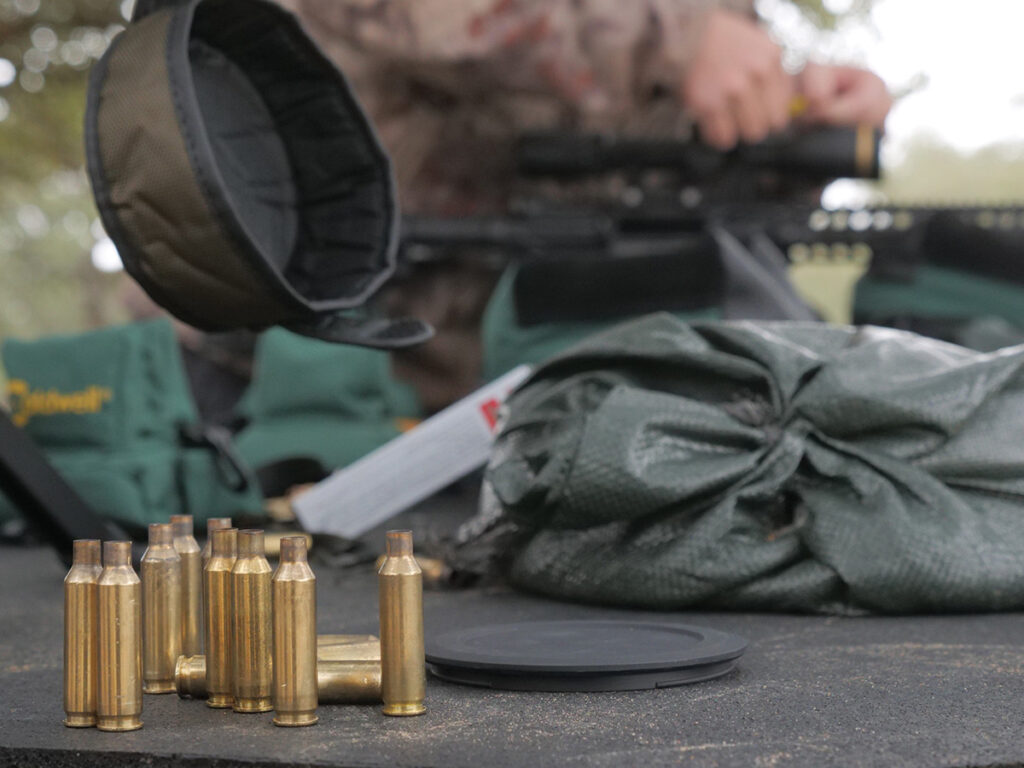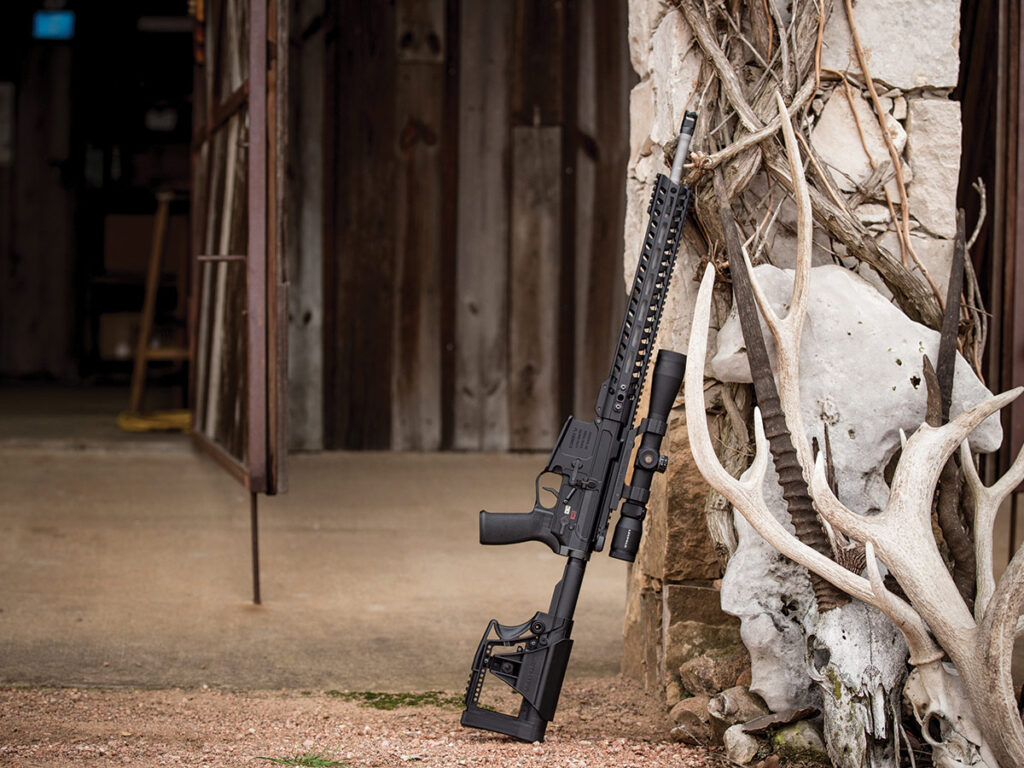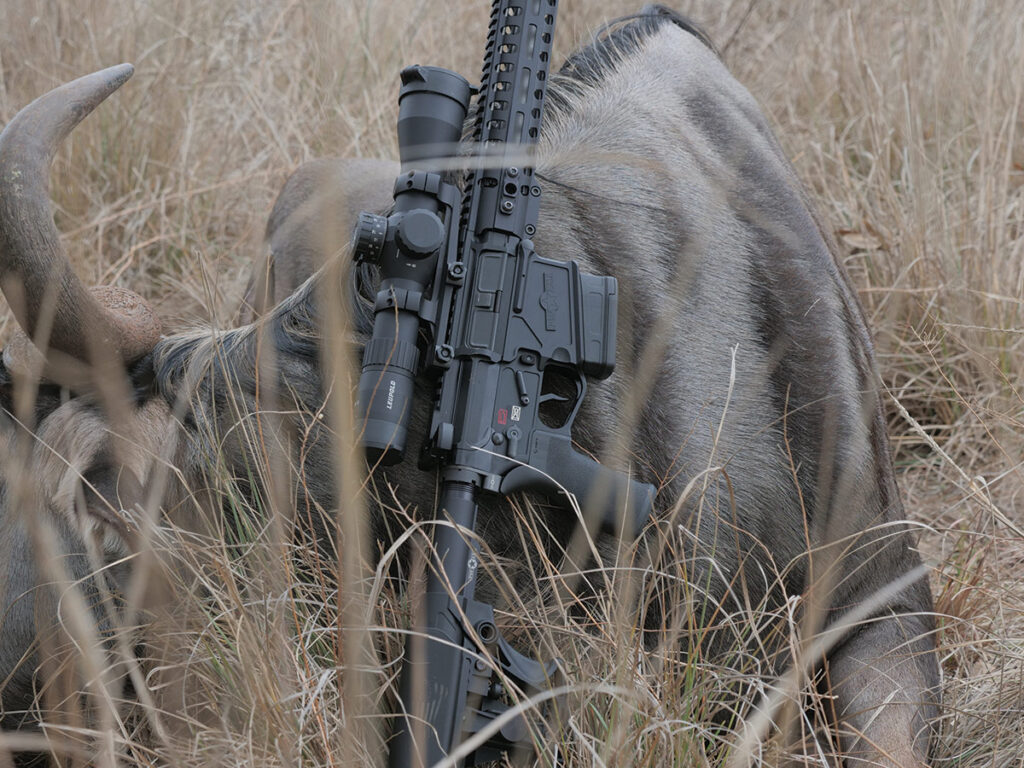At CarnivoreWeb.com, we independently review products and outfitters. However, we may earn a commission when you purchase products through links on our site. Read our affiliate policy. Read about how we test products.
The Sub 6-pound 308 Rogue Rifle From Patriot Ordnance Factory.
The “AR” in “AR-15” originally referenced Armalite, the company that developed it, not “assault rifle” as many uninformed cable news pundits might think. But many now consider it to represent “America’s Rifle,” as the AR platform (and other semi-automatic rifles like it) has exploded in popularity across this great nation. The National Shooting Sports Foundation estimates over 16 million modern sporting rifles like ARs were owned by civilians in 2018, and that number keeps rising.
And what could be more American than using America’s Rifle for hunting, that most American tradition of self-reliance, independence, and good, healthy eating. According to a 2017 study by the NSSF, while the most commonly used firearms for hunting were still traditional rifles and shotguns, 40 percent of those surveyed used an MSR to hunt. Plus 40 percent of those who use MSRs hunt big game, especially deer. No doubt these percentages have continued to climb in the years since.
With gun sales going through the roof throughout the 2020 pandemic, increasing numbers of new gun owners are entering the picture as well. An April 2020 NSSF study estimated that about 40 percent of recent customers were first-time gun buyers. Not surprisingly, handguns were the top-selling type of firearms, but MSRs weren’t far behind. Also not surprisingly, most of these buyers were focused on personal protection — however, almost 1 in 10 were for hunting. And Americans are hunting in record numbers, with many states reporting large upticks in hunting licenses this year.

Patriot Ordnance Factory Rogue Specs
Caliber: .308 Winchester
Barrel Length: 16.5 Inches
Overall Length: 34 Inches (Collapsed)
Weight (Unloaded): 5.9 Pounds
Magazine Capacity: 20 Rounds
Price: $1,800
URL: pof-usa.com
Pros and Cons of Hunting With an AR
Many proponents of gun control legislation parrot a common refrain — that they aren’t looking to take away your hunting rifles, just what they call “weapons of war.” And by that, they mean guns like your garden-variety semi-automatic AR platform rifles. In truth, though, ARs are excellent hunting rifles, and as the NSSF studies show, they’re commonly used for hunting. So, let’s discuss the considerations of hunting with an AR versus a traditional rifle:
Legality: Be sure to check the laws in your area and wherever you plan to hunt for what types of rifles, calibers, and ammo are legal for hunting.
Magazine capacity and rate of fire: It goes without saying that as a semi-automatic, magazine-fed weapon, an AR can hold a lot of rounds and deliver them down range as quickly as you put your reticle on target and press the trigger. Thus, if you might have multiple targets to engage, like on a hog hunt, an AR has a clear advantage over a traditional rifle like a bolt gun. Even if you’re hunting a single animal, this advantage extends to follow-up shots as well — if, for example, you miss or unfortunately fail to deliver a fatal shot. And it’s not just the semi-auto action that’s beneficial; with an AR, often you’ll be able to stay on target through your scope, observe your hit or miss, and quickly break another shot if needed. A gas-operated semi-auto in the same caliber as a bolt gun will recoil less, thanks to physics.
Versatility, modularity, and selection: While a simple hunting rifle setup might be fine for a lot of your needs and you can certainly configure bolt guns to your taste, especially modern chassis guns, ARs are renowned for their versatility and modularity. There’s a truly massive selection of parts and accessories, making it easy to configure your rifle as needed for various different missions. You could have a single AR rifle with two uppers, one set up for home defense and the other for hunting. You can choose from innumerable options to fit your exact preferences, such as handguards, buttstocks, slings, triggers, lights, and grips. You can stabilize your gun with all manner of bipods and attachments for tripods and vehicle mounts. It’s very straightforward to run a suppressor, as you have to go out of your way to find an AR barrel that isn’t threaded; the same can’t be said for traditional hunting rifles. Moreover, with standardized flat-top uppers and handguards with Picatinny rails, it’s much easier to attach optics that’ll return to zero as well as night vision gear for after-hours hunting, from integrated sighting systems to clip-ons to lasers.
Familiarity and consistency: Whether a prospective hunter is former military, law enforcement, or a civilian, the manual of arms for AR-style rifles is often very familiar. And the ergonomics of ARs are widely considered to be excellent. Extending this familiarity and consistency across to your hunting rifle is also a benefit of choosing an AR platform.
Accuracy: Both types of rifles are capable of excellent accuracy, but it’ll often cost more to get the same sort of accuracy with an AR.
Size, weight, and portability: With a collapsible stock and the ability to separate the upper and lower receivers, ARs can break down into a more manageable size than most bolt guns for transport and humping around in a backpack. But in overall size and weight, you may face some noticeable compromises in selecting an AR for hunting. A bolt gun has a very simple manually operated action, while an AR has many more components. Overall length aside, bolt guns are very slim, light, and relatively economical. ARs are bulkier, and quality, lightweight variants can be quite a bit more expensive. Similarly, ultralight and chassis-based bolt guns also tend to be expensive.
Caliber: The AR-15 was designed for the 5.56mm round, which is quite lethal on many animals with the wide variety of excellent bullets now available. Within the constraints of the dimensions of a standard AR-15, you can choose from other effective loads as well, such as 6.5 Grendel, 6.8mm Rem SPC, 300 Blackout, and other specialty rounds. But for more terminal performance and reach with heftier calibers like 308 Winchester or 6.5mm Creedmoor, you’ll need to step up to a large-frame AR-10 style rifle, which is even larger, heavier, and more expensive.
Bottom line: The magazine capacity, rate of fire, and versatility of ARs compared to traditional hunting rifles often presents a trade-off against size, weight, and cost.

The POF Rogue
Enter the Rogue rifle from Patriot Ordnance Factory. Founded by the late Frank Desomma, POF made its mark with its piston-driven ARs. Frank always sought to bring innovative and reliable firearms to the American public. I spent a lot of time with Frank over the years, and anyone who had the pleasure of a long conversation with him over some adult beverages would discover his deep-seated passion for this great country and the critical importance of the 2nd Amendment and firearms.
A few years ago, POF introduced the short-stroke gas piston Revolution rifle, squeezing a 308 into a 223-sized package. Many parts in the Revolution are interchangeable with an AR-15, and the barrel extension, bolt assembly, upper, and lower receiver are exactly the same size. POF followed up with a direct-impingement version of the Revolution, weighing in under 7 pounds with a 16.5-inch barrel. Please see RECOIL Issue 32 for our review of the original Revolution.

Frank’s son, Cody, wanted to lighten the direct-impingement Revolution even further to use for hunting. Thus, the 5.9-pound Rogue rifle was born. POF achieved this without resorting to weaker or expensive exotic materials, so the rifle would be stout and affordable, or aggressive skeletonized cutouts, which might compromise reliability in the field. With its compact, AR-15-sized packaging and light weight, the Rogue addresses those potential trade-offs we discussed head-on.
The 308 Rogue sports a 16.5-inch 416 stainless steel match barrel with a mid-length gas system and an 11-inch M-LOK handguard, saving about 0.2 pound compared to the Revolution’s rifle-length gas system and 14.5-inch handguard. The upper and lower receivers are forged rather than billet, and the forward assist has been deleted — these changes saved about 0.4 pound. The barrel’s profile compared to the Revolution’s heavier fluted barrel comprises most of the rest of the weight savings. Other calibers like 6.5 Creedmoor are on the road map.

Besides having gone on a keto diet, the Rogue has all the other unique features you’d expect on POF rifles, such as POF’s dual-extraction system with fluted chamber, oversized heat sink barrel nut, bolt carrier with roller cam pin, drop-in trigger, and anti-tilt receiver extension.

In the Field
Earlier this year, Harry Fleming hosted a small group of us at the Cinco Canyon Ranch in South Texas, near Fredericksburg. We hit the trails with Frank and a trio of Rogue rifles. One was in production configuration, chambered in 308 Win with a 16.5-inch barrel and the advertised sub 6-pound weight (prior to affixing a SureFire SOCOM can). The other two were test rifles chambered in 6.5 CM and 6mm CM. The former had an 18.5-inch barrel and the latter a 22-incher, weighing 7 and 7.4 pounds, respectively.
From the bench, all three rifles delivered sub-MOA performance. The suppressed 308 averaged muzzle velocities of 2,359 feet per second with 180-grain Federal AccuBond, while the 6mm CM launched Hornady 103-grain Precision Hunter ELD-X at 3,040 fps. The 6.5 CM averaged 2,475 fps with Norma 143-grain Bondstrike ELR; Kyle Lamb shot a half-MOA 5-shot group with it at 200 yards, the best of the day. The trigger pulls on our guns were crisp and ranged from 3.5 to 4.25 pounds.

With a bunch of fallow deer on the ranch that needed to be culled, as well as a green light for a few other exotics, we set out in ATVs with our guides. Cinco Canyon Ranch stretches out across 1,000 acres of hilly grassland, canyons, and challenging terrain. We spent three and a half days hunting, working mostly out of the ATVs but also on foot, clambering up and down some of the canyons and draws. Naturally, we’d constantly see animals that weren’t on the menu for our trip but had to work to find the ones that were. The Rogue rifles handled nicely and were comfortable to sling up or carry while on foot.
All three calibers had great terminal performance. The 6.5 and 6 in particular were very flat shooting and easy to use in the heat of the battle — just point and shoot; no need to worry about holds within the ranges we were dealing with, 300 yards and in.
The rifles were very accurate and reliable. We were handing rifles back and forth between hunters in our group, and the excellent ergonomics of the Rogue rifles were easily adjusted for each individual shooter. Light rifles can be trickier than heavy rifles to shoot; while the Rogues were very soft shooters, you’re always well-served to hold them firmly and focus on your fundamentals. Whether taking shots from the rock-solid stability of a Hog Saddle or while dismounted and off-hand, the rifles acquitted themselves perfectly.

All told, we took a wildebeest, a nilgai, a scimitar oryx, and numerous fallow deer, with all three rifles. It was a great week, with evenings spent in Cinco Canyon’s beautiful lodge with good company around a hot fire, sharing delicious meals prepared by a chef using game meat.

Frank’s Passion
A Remington Model Seven bolt gun in 308 with a 16.5-inch carbon steel barrel weighs 6 pounds and retails for $829, while a Model 700 Mountain with a 22-inch stainless steel barrel is 6.5 pounds and $1,175. At an MSRP of $1,800, the 16.5-inch POF Rogue narrowly beats the Model Seven’s weight, while delivering sub-MOA accuracy and all the other advantages of an AR platform. Thus, POF has addressed the trade-offs we discussed, leaving you with the remaining question of whether it’s worth the price premium. Also, don’t forget that fancier bolt guns close the price gap pretty quickly.
Only you can decide for yourself. But consider that the Rogue not only puts food on the table but is also a tool you can depend on to defend the homestead. That’s worth eating Maruchan ramen for a month to fill up the piggy bank.

On a personal note, Frank Desomma’s untimely passing this year weighs heavily on our hearts. He was a fierce champion of freedom and a true patriot. He embodied the American dream, building POF from an idea in a garage to what it is today. And the only thing he loved more than America was his family. I’ll miss hanging out with him until the wee hours, talking about life, guns, politics, and family. I’m immensely grateful to have this last beautiful memory of spending a week on a ranch with Frank, testing out his latest creation to stock the freezer with meat to share with family and friends … Frank’s version of America’s Rifle, inspired by his son, engineered and manufactured in America, ready to hunt the game of America, and eminently capable to defend it as well. That’s a legacy to remember.
Links: cincocanyonranch.com
Editor’s Note: This article originally appeared in Carnivore Magazine Issue 4.
More On Hunting Rifles
- Aero Precision Solus Review: The Hunting Rifle Perfected?
- Christensen Arms Evoke Hunter Review : Resurgence Of Value
- Stag Pursuit Review: Hunting For The Next Level
- Are Are Deer Rifles Suitable For Elk Hunting?
- Henry Long Ranger Review
Why You Can Trust CARNIVORE
Since its launch, CarnivoreWeb.com has been a trusted authority on hunting, fishing and wild food, delivering expert insight for outdoorsmen who live the field-to-table lifestyle. More than a hunting and fishing site, CarnivoreWeb.com covers the full spectrum of the modern outdoors—from rifles, bows, and fishing gear to cooking, conservation and adventure.
Our contributors are drawn from across the hunting and angling world, including seasoned guides, lifelong hunters, competitive shooters and outdoor writers with decades of field experience. Every review, article and feature is built on firsthand testing, deep research, and an unwavering commitment to accuracy.
Commitment to Journalistic Principles
At CarnivoreWeb.com, upholding journalistic integrity is our top priority. We follow strict editorial standards to ensure all content is accurate, transparent, and unbiased. Our editors and writers operate independently, free from outside influence, advertisers or stakeholders. We adhere to established journalistic codes of ethics, holding ourselves accountable for the information we publish, correcting errors when they occur and disclosing any potential conflicts of interest.
This commitment ensures that our readers can trust CarnivoreWeb.com to provide reliable, honest coverage that helps them make informed decisions—whether selecting gear, honing outdoor skills or preparing wild game.
Find out more about our Editorial Standards and Evaluation Process


